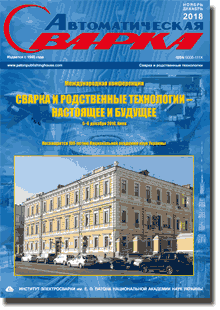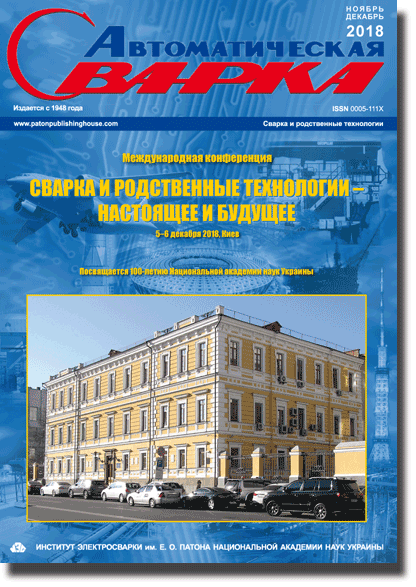| 2018 №12 (04) |
DOI of Article 10.15407/as2018.12.05 |
2018 №12 (06) |

Avtomaticheskaya Svarka (Automatic Welding), #11-12, 2018, с. 58-68
Low stress no distortion welding based on thermal tensioning effects
Qiao Guan
Chinese Academy of Engineering, Beijing Aeronautical Manufacturing Technology Research Institute (BAMTRI). PO Box 863, 100024, Beijing, China. E-mail: guanq@cal.cn
In manufacturing sheet metal formed plates, panels and shells by welding, buckling distortions become substantial especially for aerospace structures with material thickness less than 4 mm. To prevent buckling, Low Stress No Distortion (LSND) welding techniques have been pioneered and developed at the Beijing Aeronautical Manufacturing Technology Research Institute. These innovative techniques have been applied successfully in manufacturing aerospace structural components. In this paper, the mechanisms of LSND welding techniques using either the whole cross-sectional thermal tensioning effect or the localized thermal tensioning effect are described and summarized in detail. The basic idea of LSND welding techniques is to perform active in-process control of inherent plastic (incompatible) strains and stresses formation during welding to achieve distortion-free results so that no costly post weld reworking operations for distortion correction is required. Emphasis is given to the finite element analysis to predict and optimize the localized thermal tensioning technique with a trailing spot heat sink coupled to the welding heat source. Selection of parameters for engineering solution are recommended. 21 Ref., 1 Tabl., 15 Fig.
Keywords: welding residual stress, low stress no distortion welding, buckling distortion, thermal tensioning, temperature gradient stretching, finite element analysis
Received: 15.05.2018
Published: 06.11.2018
References
1. Terai, K. (1978) Study on prevention of welding deformation in thin-skin plate structures. Kawasaki Technical Review. (61): 61-66.
2. Masubuchi, K. (1980) Analysis of welded structures. Oxford, Pergamon Press.
3. Guan, Q. (1999) A survey of development in welding stress and distortion control in aerospace manufacturing engineering in China, Welding in the World, 43(1): 14-24.
4. Guan, Q., Guo, D. L. et al. (1987) Method and apparatus for low stress no-distortion welding of thin-walled structural elements. Original Chinese patent 87100959.5. 1988.International patent specification No PCT/GB88/00136.
5. Guan, Q., Zhang, C. X. et al. (1993) Dynamically controlled low stress no-distortion welding method and its facility. Chinese patent 93101690.8.
6. Zhong, X. M., Murakawa, H. and Ueda, Y. (1995) Buckling behavior of plates under idealized inherent strain. Transactions of JWRI. 24(2): 87-91.
7. Michaleris, P. et al. (1999) Minimization of welding residual stress and distortion in large structures. Welding Journal. 78(11): 361-s to 366-s.
8. Deo, M. V., Michaleris, P. (2003) Mitigating of welding induced buckling distortion using transient thermal tensioning. Science and Technology of Welding and Joining. 8(1): 49-54. https://doi.org/10.1179/136217103225008919
9. Tsai, C. L. et al. (1999) Welding distortion of a thin-plate panel structure . Welding Journal. 78(5): 156-s to 165-s.
10. Paton, B. E. et al. (1989) Fabrication of thin-walled welded large panels of high strength aluminum alloys. Avt. Svarka. (10) (in Russian).
11. Radaj, D. (1992) Heat effects of welding: temperature field, residual stress, distortion. Berlin, Springer-Verlag. https://doi.org/10.1007/978-3-642-48640-1
12. Guan, Q. et al. (1990) Low stress no-distortion (LSND) welding — a new technique for thin materials. Transactions of Chinese Welding Society. 11(4): 231-237 (in Chinese).
13. Burak, Ya. I. et al. (1977) Controlling the longitudenal plastic shrinkage of metal during welding. Avt. Svarka (3): 27-29.
14. Burak, Ya. I. et al. (1979) Selection of the optimum for preheating plates before welding. Avt. Svarka (5): 5-9.
15. Mechaleris, P. et al. (1995) Analysis and optimization of weakly coupled thermo-elasto-plastic systems with application to weldment design, Int. J. for Numerical Methods in Engineering. 38:1259-1285. https://doi.org/10.1002/nme.1620380803
16. Yang, Y. P., Dong, P., Zhang, J. and Tian, X. T. (2000) A hot-cracking mitigation technique for welding high-strength aluminum alloy. Welding Journal. 79(1): 9-s to 17-s.
17. Dong, P. et al. (1998) Analysis of residual stresses in Al-Li repair welds and mitigation techniques. Welding Journal. 77(11): 439-s to 445-s.
18. Guan, Q. et al. (1996) Low stress no-distortion welding for aerospace shell structures. China Welding. 5(1): 1-9.
19. Guan, Q., Zhang, C. X. et al. (1994) Dynamic control of welding distortion by moving spot heat sink. Welding in the World, 33(4): 308-313.
20. Li, J., Guan, Q., Shi, Y. W. et al. (2004) Studies on characteristics of temperature field during GTAW with a trailing heat sink for titanium sheet. Journal of Materials Processing Technology. 147(3): 328-335. https://doi.org/10.1016/j.jmatprotec.2003.12.012
21. Li, J., Guan, Q., Shi, Y. W. and Guo, D. L. (2004) Stress and Distortion mitigation technique for welding titanium alloy thin sheet. Science and Technology of Welding and Joining, 9, 5, 451-458. https://doi.org/10.1179/136217104225021643
The cost of subscription/purchase order journals or individual articles
| Journal/Currency | Annual Set | 1 issue printed |
1 issue |
one article |
| TPWJ/USD | 384 $ | 32 $ | 26 $ | 13 $ |
| TPWJ/EUR | 348 € | 29 € | 24 € | 12 € |
| TPWJ/UAH | 7200 UAH | 600 UAH | 600 UAH | 280 UAH |
| AS/UAH | 1800 UAH | 300 UAH | 300 UAH | 150 UAH |
| AS/USD | 192 $ | 32 $ | 26 $ | 13 $ |
| AS/EUR | 180 € | 30 € | 25 € | 12 € |
| SEM/UAH | 1200 UAH | 300 UAH | 300 UAH | 150 UAH |
| SEM/USD | 128 $ | 32 $ | 26 $ | 13 $ |
| SEM/EUR | 120 € | 30 € | 25 € | 12 € |
| TDNK/UAH | 1200 UAH | 300 UAH | 300 UAH | 150 UAH |
| TDNK/USD | 128 $ | 32 $ | 26 $ | 13 $ |
| TDNK/EUR | 120 € | 30 € | 25 € | 15 € |
AS = «Automatic Welding» - 6 issues per year;
TPWJ = «PATON WELDING JOURNAL» - 12 issues per year;
SEM = «Electrometallurgy Today» - 4 issues per year;
TDNK = «Technical Diagnostics and Non-Destructive Testing» - 4 issues per year.





